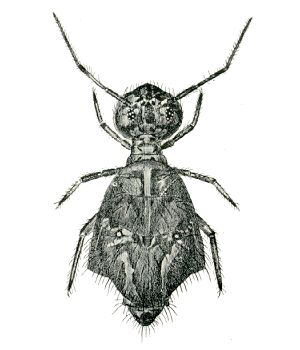Top Qs
Timeline
Chat
Perspective
Sminthuridae
Family of springtails From Wikipedia, the free encyclopedia
Remove ads
Sminthuridae (Lubbock, 1862), not to be confounded with: Sminthurididae (Börner, 1906), is a family of springtails of the order Symphypleona.[1][2] Sminthurids are commonly referred to as globular springtails.[3][4]
Remove ads
Description
Like other Symphypleona, Sminthuridae are globular in shape and have a furcula that allows them to jump. Members of this family have four-segmented antennae in which the basal segment is short and the rest successively increase in length. The terminal antennal segment has about 20 whorls of hairs and is divided into numerous subsegments. Sminthuridae also have well-developed tracheae. The dens has many setae, unlike in Mackenziellidae where it has 3 setae. Females have subanal appendages.[5][6]
Remove ads
Ecology
Sminthuridae occur in surface litter layers, on vegetation and in tropical forest canopies. They may be collected using Tullgren funnels or pitfall traps, or by sweeping through grass with a pan.[7] Additionally, Sminthuridae is one of the springtail families that includes species living in freshwater.[8]
List of genera
Thirteen genera are placed within the Sminthuridae:[1][9]
- Allacma Borner, 1906
- Arrhopalites Borner, 1906
- Bourletiella Banks, 1899
- Caprainea Dallai, 1970
- Collophora Richards, 1964
- Dicyrtoma Bourlet, 1842
- Lipothrix Borner, 1906
- Neosminthurus Mills, 1934
- Ptenothrix Borner, 1906
- Sminthurus Latreille, 1802
- Spatulosminthurus Betsch & Betsch-Pinot, 1983
- Sphyrotheca Borner, 1906
- Vesicephalus Richards, 1964
Notable species
- Allacma fusca, a common European species[citation needed]
- Sminthurus viridis, the lucerne flea, an introduced pest species in Australia[10][11]
References
Wikiwand - on
Seamless Wikipedia browsing. On steroids.
Remove ads

